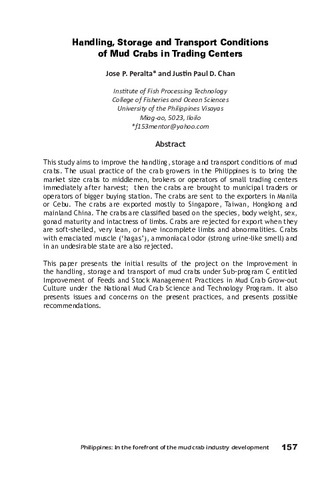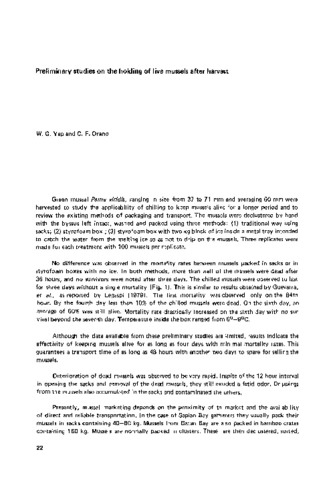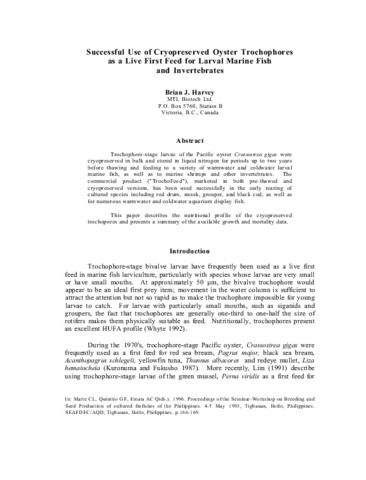Handling, storage and transport conditions of mud crabs in trading centers
| dc.contributor.author | Peralta, Jose P. | |
| dc.contributor.author | Chan, Justin Paul D. | |
| dc.contributor.editor | Quinitio, Emilia T. | |
| dc.contributor.editor | Parado-Estepa, Fe Dolores | |
| dc.contributor.editor | Coloso, Relicardo M. | |
| dc.date.accessioned | 2017-08-25T09:09:43Z | |
| dc.date.accessioned | 2017-08-25T16:35:11Z | |
| dc.date.available | 2017-08-25T09:09:43Z | |
| dc.date.available | 2017-08-25T16:35:11Z | |
| dc.date.issued | 2017 | |
| dc.identifier.citation | Peralta, J. P., & Chan, J. P. D. (2017). Handling, storage and transport conditions of mud crabs in trading centers. In E. T. Quinitio, F. D. Parado-Estepa, & R. M. Coloso (Eds.), Philippines : In the forefront of the mud crab industry development : proceedings of the 1st National Mud Crab Congress, 16-18 November 2015, Iloilo City, Philippines (p. 157). Tigbauan, Iloilo, Philippines: Aquaculture Department, Southeast Asian Fisheries Development Center. | en |
| dc.identifier.isbn | 9789719931072 | |
| dc.identifier.uri | http://hdl.handle.net/10862/3193 | |
| dc.description | Abstract only. | en |
| dc.description.abstract | This study aims to improve the handling, storage and transport conditions of mud crabs. The usual practice of the crab growers in the Philippines is to bring the market size crabs to middlemen, brokers or operators of small trading centers immediately after harvest; then the crabs are brought to municipal traders or operators of bigger buying station. The crabs are sent to the exporters in Manila or Cebu. The crabs are exported mostly to Singapore, Taiwan, Hongkong and mainland China. The crabs are classified based on the species, body weight, sex, gonad maturity and intactness of limbs. Crabs are rejected for export when they are soft-shelled, very lean, or have incomplete limbs and abnormalities. Crabs with emaciated muscle (‘hagas’), ammoniacal odor (strong urine-like smell) and in an undesirable state are also rejected. This paper presents the initial results of the project on the Improvement in the handling, storage and transport of mud crabs under Sub-program C entitled Improvement of Feeds and Stock Management Practices in Mud Crab Grow-out Culture under the National Mud Crab Science and Technology Program. It also presents issues and concerns on the present practices, and presents possible recommendations. | en |
| dc.language.iso | en | en |
| dc.publisher | Aquaculture Department, Southeast Asian Fisheries Development Center | en |
| dc.subject | Scylla | en |
| dc.subject | Philippines | en |
| dc.title | Handling, storage and transport conditions of mud crabs in trading centers | en |
| dc.type | Conference paper | en |
| dc.citation.spage | 157 | |
| dc.citation.conferenceTitle | Philippines : In the forefront of the mud crab industry development : proceedings of the 1st National Mud Crab Congress, 16-18 November 2015, Iloilo City, Philippines | en |
| dc.subject.asfa | stress | en |
| dc.subject.asfa | consumers | en |
| dc.subject.asfa | crab culture | en |
| dc.subject.asfa | fish storage | en |
| dc.subject.asfa | fishery products | en |
| dc.subject.asfa | handling | en |
| dc.subject.asfa | harvesting | en |
| dc.subject.asfa | live storage | en |
| dc.subject.asfa | marine crustaceans | en |
| dc.subject.asfa | postharvest losses | en |
| dc.subject.asfa | purchasing | en |
| dc.subject.asfa | trade | en |
| dc.subject.asfa | transportation | en |
このアイテムのファイル
このアイテムは次のコレクションに所属しています
-
Philippines : In the forefront of the mud crab industry development [44]
Proceedings of the 1st National Mud Crab Congress





